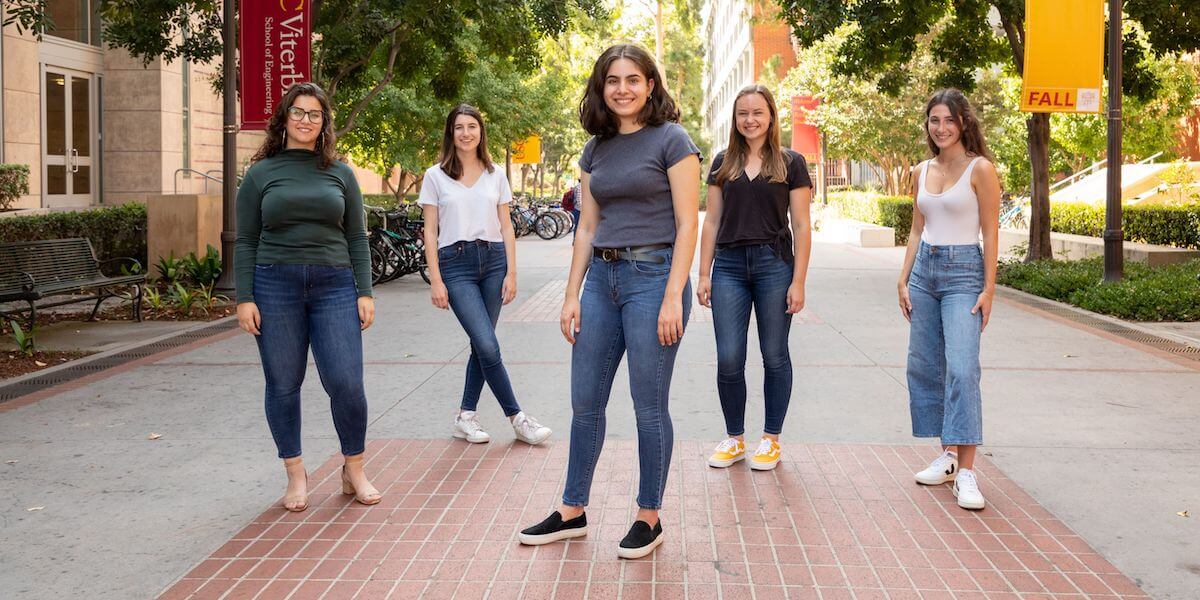
The Marlink team (Left to Right) Co founder Maria Camasmie, Co Founder Siena Applebaum, Co Founder Roxanna Pakkar, Co Founder Celeste Goodwin and Co Founder Sofia Tavella (Photo/Tracy + David Stills and Motion)
It all started with Jupiter. Specifically, Jupiter’s icy moon, Europa. Roxanna Pakkar, then an intern at NASA’s Jet Propulsion Laboratory, listened with rapt attention at a 2018 lecture about exploring extraplanetary oceans. Robots, she learned, would likely be the first interplanetary Magellans, voyaging beneath Europa’s vast ocean.
The problem? Communication.
The presentation led Pakkar to meet with fellow USC Viterbi student Celeste Goodwin to brainstorm ideas for improving underwater communication, with a focus on space. After a conversation with her JPL mentor, though, Pakkar concluded that improving underwater communication on Earth was equally important — and easier to pursue.
From those discussions, a USC Viterbi startup called Marlink was born. Its members are five undergraduates: Pakkar, an electrical engineering major; Goodwin, Siena Applebaum and Sofia Tavella, all mechanical engineering majors; and Maria Camasmie, a former mechanical engineering major who recently switched to narrative studies. Together, these women are developing an underwater wireless communication technology that could allow greater exploration of the ocean at a lower cost than currently possible.
Their efforts have drawn considerable interest. On Friday, Sept. 13, Marlink will represent the United States at the Global Grand Challenges Summit student competition finals in London, along with groups from both the United Kingdom and China.
One likely destination: coral reefs. Making up only 1 percent of the ocean floor but home to more than 25 percent of marine life, coral reefs play a vital role in the well-being of the oceans. Nearly half a billion people rely on them as an important source of food and income, according to the National Oceanic and Atmospheric Administration.
However, an estimated one-quarter of the world’s reefs have disappeared over the past 30 years. Rising sea temperatures, industrial and plastic pollution, and sewage are among the main culprits.
Given the precarious state of the world’s reefs, scientists have looked for better and more efficient ways to monitor their health. Marlink has come up with a promising new approach for exploring the sea, as well as for surveying oil rigs and underwater pipelines.
Unlike other systems, Marlink “enables the next generation of wireless underwater communication by pairing the robust, long range of acoustic technology with the high data rates of optical technology,” Camasmie explained.
Currently, operators of wireless autonomous underwater vehicles (AUVs) have to remove them from the water to download data or reprogram them. That’s because AUVs typically only employ acoustic waves, “which limit the type of data that can be transmitted,” Applebaum said. “So, after deploying an AUV, operators are in the dark about its findings and its status until it completes its preprogrammed mission, resurfaces and is retrieved.”
By contrast, Marlink allows the real-time transmission of large data packets within its wireless optical range of about 500 meters. That permits operators to retrieve information from and redirect autonomous underwater vehicles wirelessly, “saving both time and money,” Applebaum said, noting that single AUV resurfacing could cost as much as $50,000.
“Researchers working tirelessly to unlock the solutions to climate change will be able to use Marlink devices to access the far reaches of the oceans, where these answers are waiting to be found,” Pakkar said. “By protecting our existing ecology and furthering our understanding of our planet and beyond, we’ll be better prepared to sustain a population of 10 billion people on Earth.”
Marlink makes a splash
Marlink — the name of both the company and of the physical node that operators mount to the bottoms of buoys or the ocean floor to transmit data packets to and from AUVs — has made a splash. The all-female startup won second place in the 2019 Maseeh Entrepreneurship Prize Competition (MEPC), consulting with AUV and ocean engineering researchers at NASA, Boeing and the U.S. Navy in the process. And Marlink is one of five teams to represent the United States at the NAE’s Global Grand Challenges finals.
“Marlink is a wonderful team of undergraduate student innovators with strong entrepreneurial spirit and leadership that changes the conversation about technology entrepreneurship,” said USC Viterbi Dean Yannis C. Yortsos. “They will surely enrich the Grand Challenges Global Summit with their presence, their ideas and their mindset.”
Marlink’s promise to improve wireless underwater communication at a reduced cost excites environmental researchers and oil and gas companies alike, team members said. For instance, offshore rig operators could more efficiently monitor their operations to detect leaks, Goodwin said. If they discover a leak, she added, they could quickly redeploy resources, including AUVs, to prevent a full-scale disaster.
“Marlink has such a wide range of uses because our device can optimize communication for any industry interested in underwater exploration, including defense, oil and gas, environmental agencies and researcher institutions,” said Tavella, who spent the summer teaching a 3-D printing and design course at Columbia University for middle and high school students interested in engineering. “Whether it be fish profiling, monitoring the condition of oil rigs, tsunami detection or exploring new areas of the ocean, Marlink can play a role.”
From the heavens to the Earth
Last fall, Pakkar shared her idea with her future Marlink teammates, all good friends who bring unique skills to the project.
As the group’s sole electrical engineer, Pakkar, a Microsoft summer intern, possesses the most knowledge about underwater communication and technology. Goodwin, who also interned at Microsoft, has a background in project management. Camasmie, because of her experience in technical sales, including interning at IBM last summer, oversees market analysis.
Tavella, considered Marlink’s most creative member, leads its graphic design and hardware design. Applebaum — another summer intern at Microsoft who earlier this year traveled to Lesvos, Greece, as part of a five-member student team that built a low-cost shower system to help refugees — brings manufacturing and computer aided design experience to the firm.
“We are all naturally motivated by new challenges, which is what has made Marlink a successful team,” Applebaum said. “Being ambitious, persistent and up for a challenge is what united us and has enabled us to take our idea as far as we have.
“In the future, I hope we can see some variation of Marlink hit the market,” she added.
Published on September 11th, 2019
Last updated on September 12th, 2019













